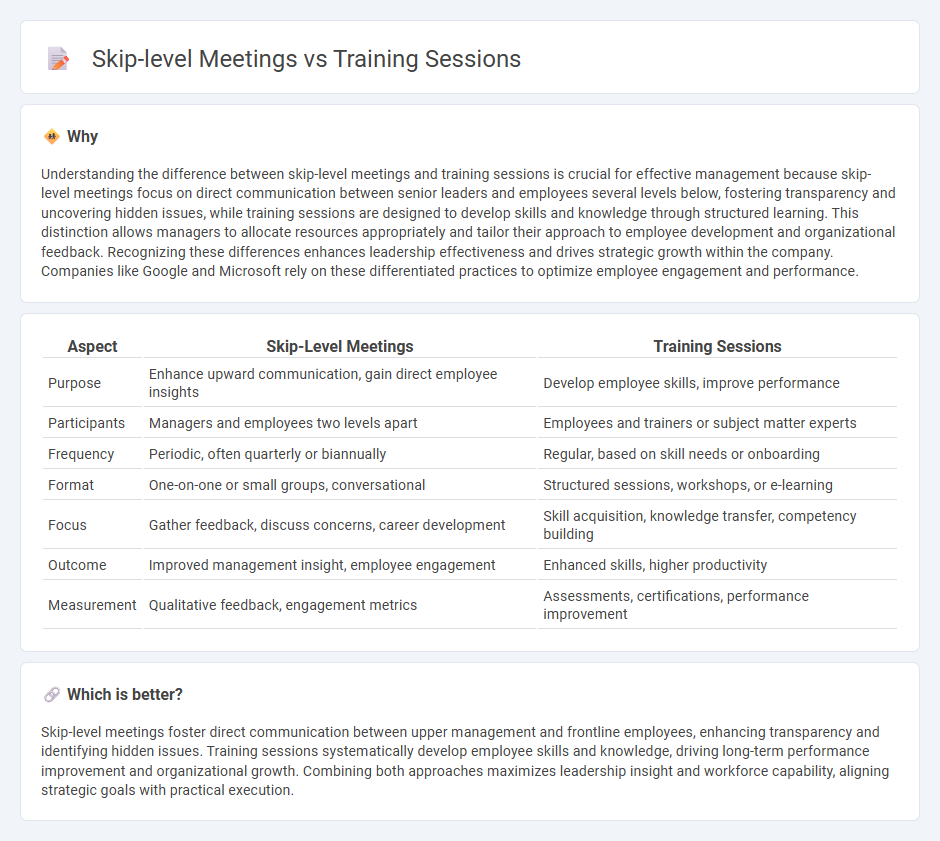
Skip-level meetings create direct communication channels between senior leaders and frontline employees, promoting transparency and uncovering insights often missed in traditional hierarchies. Training sessions focus on skill development and knowledge transfer, equipping employees with tools to enhance performance and drive organizational success. Discover how integrating both approaches can optimize team engagement and operational efficiency.
Why it is important
Understanding the difference between skip-level meetings and training sessions is crucial for effective management because skip-level meetings focus on direct communication between senior leaders and employees several levels below, fostering transparency and uncovering hidden issues, while training sessions are designed to develop skills and knowledge through structured learning. This distinction allows managers to allocate resources appropriately and tailor their approach to employee development and organizational feedback. Recognizing these differences enhances leadership effectiveness and drives strategic growth within the company. Companies like Google and Microsoft rely on these differentiated practices to optimize employee engagement and performance.
Comparison Table
| Aspect | Skip-Level Meetings | Training Sessions |
|---|---|---|
| Purpose | Enhance upward communication, gain direct employee insights | Develop employee skills, improve performance |
| Participants | Managers and employees two levels apart | Employees and trainers or subject matter experts |
| Frequency | Periodic, often quarterly or biannually | Regular, based on skill needs or onboarding |
| Format | One-on-one or small groups, conversational | Structured sessions, workshops, or e-learning |
| Focus | Gather feedback, discuss concerns, career development | Skill acquisition, knowledge transfer, competency building |
| Outcome | Improved management insight, employee engagement | Enhanced skills, higher productivity |
| Measurement | Qualitative feedback, engagement metrics | Assessments, certifications, performance improvement |
Which is better?
Skip-level meetings foster direct communication between upper management and frontline employees, enhancing transparency and identifying hidden issues. Training sessions systematically develop employee skills and knowledge, driving long-term performance improvement and organizational growth. Combining both approaches maximizes leadership insight and workforce capability, aligning strategic goals with practical execution.
Connection
Skip-level meetings foster direct communication between upper management and frontline employees, uncovering insights that inform targeted training sessions. Training programs designed based on feedback from skip-level meetings enhance employee skills and align development with organizational goals. This connection promotes a culture of continuous improvement and effective leadership engagement.
Key Terms
Skill Development (Training Sessions)
Training sessions prioritize structured learning environments designed to enhance specific skills through targeted exercises and expert guidance, facilitating measurable improvement in employee competencies. These sessions employ varied methodologies such as hands-on workshops, e-learning modules, and role-playing activities to address skill gaps and foster professional growth. Explore more about optimizing training sessions for effective skill development and workforce excellence.
Organizational Alignment (Skip-Level Meetings)
Skip-level meetings enhance organizational alignment by fostering direct communication between upper management and employees, bypassing immediate supervisors. These interactions uncover insights into team dynamics, identify roadblocks, and align strategic objectives across all levels of the organization. Discover how skip-level meetings can transform your company's alignment and drive cohesive team performance.
Communication Flow
Training sessions enhance communication flow by standardizing knowledge and aligning team skills, which fosters consistent messaging across the organization. Skip-level meetings improve upward communication by providing direct channels between senior leaders and employees, uncovering insights and challenges that may be missed in regular hierarchies. Discover how combining these approaches can optimize communication dynamics in your organization.
Source and External Links
How to Create an Unforgettable Training Session - This article provides guidance on crafting effective training sessions, including setting objectives, applying adult learning principles, and designing engaging activities.
What Is a Training Session? - This resource explains the importance of training sessions for employee development and organizational growth, offering tips on planning and executing successful sessions.
28 Training Activities and Games - This article lists fun and inclusive activities to enhance in-person and virtual training sessions, promoting engagement and understanding.
 dowidth.com
dowidth.com